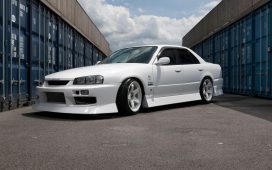From the May 1975 issue of Car and Driver.
Old Colin Chapman really head-faked your average sports-car freak right out of his Adidases with this one. There he was: Joe Enthusiast, firm in his knowledge that Lotuses are miniature fiberglass sports cars that you slip on like pantyhose; an unquestioning subscriber to the party line that Lotuses are fragile machines that shed nuts, bolts, clips and pieces of bodywork like an Alsatian sheds hair; a confirmed disciple spreading the gospel that Lotus cars are the ultimate in two-seaters this side of Uranus. He has Lotus pigeonholed so tightly that he doesn’t even have to read road tests to shore up his opinions anymore. In fact, he could probably write a convincing road test by just repeating the stories he’s heard a hundred times before: “exhilarating but unreliable . . . comfy but cramped” and on and on.
Then Chapman charges in, feints with his World Champion Car Constructor’s badge and dunks the big new four-passenger semi-station wagon Elite into showrooms everywhere for another two points on the scoreboard.
Lotus freaks are going crazy. The Elan has been out of production for nearly two years now. Europas are no longer being imported. The only new Lotus you can buy (after the leftover Europas are cleared out) is a four-passenger transporter. The diehards suspect that Chapman turned 40 and stepped off the deep end all in one deft motion.
The comedy of all this is that if the Elite said Jaguar or BMW or even Chevrolet on the fender, enthusiasts would be hailing it as the most significant new concept in sporting motoring since the Porsche 911. But since the badges unmistakably say Lotus, they are disappointed. The Elite is too big and too comfortable and too solid and altogether too competent as a transportation device to be a real Lotus.
But there are a lot of enthusiastic drivers—some of them on the staff of Car and Driver—who think that “real” Lotuses are too strong a dose. Formula-racer performance on the street may be exhilarating, they say, but some of it could be traded for a little more space between the pedals—at least enough so that one size-10 foot didn’t press all three at the same time. And it would be nice to hear the radio at freeway speeds and not have to drive with one hand and hold the car together with the other. No, your original tongue-out, wind-in-the-hair Lotus isn’t for everybody. And maybe it’s not for Colin Chapman anymore either.
The Elite is, above all things, civilized. The seats are soft, the air conditioning is ample and the noise is subdued. You could never have said that about Lotuses before. Yet the car is radical in its own way—because radical is the only way to describe fitting four passengers into a car that is shorter and lower than a Corvette. Make no mistake, the Elite is a full four-passenger car. You can have a six-footer up front driving—kneeroom, elbowroom, headroom and everything—and fit another one like him just behind in the back seat.
Getting in is not easy—it never will be in a car that is less than 48 inches high—but the accommodations are worth the effort. The body-hugging rear seats are like sitting in a well-upholstered Formula One car and probably as close as most of us will ever come to it. In fact, the Elite is one car in which you could make a strong case for a rear seat being a more exciting place than the front. There you are, cradled in woven nylon from neck to knee. The driveshaft tunnel makes a perfect armrest in the center; the quarter panel is molded to do the same job on the other side. Just settle back against the headrest and let yourself be transported.
Why aren’t Camaros like this? And Mustangs? And Monzas? How can Colin Chapman, who is supposed to be a racer and therefore know nothing about passenger-car design, produce a more efficient passenger car than General Motors or Ford? The crushing indictment is that the Elite’s trunk has greater capacity than that of a Camaro too, and more than a Mustang or Monza if you leave the rear seat erect in those hatchback coupes. All of this tells you something about the scope of the imagination in Detroit product-planning offices.
The Lotus Elite would be a significant new automobile if only for its efficient passenger-packaging—but that is only half the story. This car is also one of the most agile and athletic four-sealers on the road, better by far than most “true” sports cars. It has the kind of taut yet supple suspension that strides over the bumps and bits into the curves as only a Lotus can. The car begs to be driven hard and fast.
Despite the Elite’s size and station-wagon shape, it remains a Lotus right down to its steel-backbone chassis. The steering is heavy at low speeds and the clutch is quick, so you kind of wrestle it out of its parking slot. If you drive sedately around the block, the Elite feels more or less like any other sports coupe, though it may take a while to get used to a windshield that rakes back to your forehead. But there is a definite limit to how exciting any car can be straight and level at 20 mph, and the Lotus is bound by that limit just as is every Chevrolet. So it’s only when you give free rein to your exuberance that you discover what a thoroughbred the Elite really is. The steering gets lighter and quicker the faster you go, and the car will bend through curves at amazing speeds without even a noticeable drift angle. The Elite is so well balanced that you’d really have to try to get into trouble. There is a mild understeer working against you at all times; if you really fling it, the tail will come loose. But these things all happen at speeds that are well into the range of indiscretion on the street.
There is nothing at all mysterious about what makes Lotuses such fun to drive. Obviously they have disciplined and sophisticated independent suspension systems, but even more important is their low overall weight (in the case of the Elite, 2625 pounds). Light cars don’t have to be muscled around; gentle urgings will do. And when the controls are accurate and well-located, as they are in the Elite, you can play them like a virtuoso. Few are the four-passenger cars that generate these sort of high feelings, and none of them are American.
Even so, the Elite caters to its passengers in a very American way, as it should for $16,300. Power brakes, electric windows, air conditioning (with the superb vibration-free GM compressor) and AM/FM stereo tape are standard equipment. Only the engine seems lacking, and even that is relative. The double-overhead-cam, four-valve-per-cylinder, allaluminum engine would clearly be the greatest thing that ever happened to a Pinto. It’s a 2.0-liter four that revs to 7000, turns out an advertised 140 hp and would produce unprecedented bursts of acceleration in the compact Ford. It doesn’t do badly at all in the Lotus, either—16.7 seconds and 83.5 mph in the quarter mile.
But there is more to engines than documented horsepower and exotic specifications. Cylinders, for example, and you usually expect a lot of them for this kind of money. With the Elite you only get four, plus all the vibration that entails. Lotus engineers have done well indeed with their isolation efforts and the engine has a commendably flexible power curve, but you still know it’s a four—which is adequate but not “elite.”
Worst of all, it brings you down, breaks the spell of magic that otherwise surrounds the car. This Lotus is an extraordinarily seductive machine. It has all of the surface attractions that distinguish expensive GT cars: a dramatically low roof-line; a voluptuous interior trimmed in woodgrain, buckskin corduroy and beige flannel; and the kind of exclusivity that almost certainly guarantees you double-takes in the parking lot of the country club. At the same time, it shimmers with technology. The body is molded of fiberglass in two pieces, joined together at the waistline and honed to a fine aerodynamic edge. The suspension is fully independent (as Chapman’s cars have been for years) and the drum rear brakes are located inboard to reduce unsprung weight. To this are added a few practical touches, like a gas tank with inlets on both sides of the car (so that it never matters how you pull up to a gas pump) and a wiper on the rear glass to aid visibility on rainy days. It’s a car in which you can take genuine pleasure for a broad variety of reasons. But best of all, you can slip into that left front bucket seat and make it fly.
Nevertheless, the Elite has precipitated much confusion among the purists. Even the dealers are insecure—not only have they been used to dealing in the most intense type of sports cars on the market, but their previous wares were ticketed at about half the price of the Elite. So this car requires a whole new strategy. The dealers are now grappling with the sales value of rear seats and talking about fuel economy, which usually is the last feature to be mentioned in discussions of $16,000 GT cars.
Yet it is a valid point. The C/D test Elite averaged close to 20 mpg during routine street driving. We should also point out that it was a 1974 model. No 1975s were available as this was being written, and none were expected until mid-April or even later. You could read that to mean a good supply of last year’s models is still available—which is the case. And which is no small part of the dealer’s current unease.
Actually, they have nothing to worry about. Car enthusiasts are notably slow to forget old favorites and equally reluctant to embrace what they see as watered-down designs. But the Elite is not a diluted Elan with a back seat. Rather, it’s a Mustang II taken to the very highest limits, just as it could be said that an Elan was a much-massaged MGB refined until it was an unmistakably pure sports car. The word will get out on the Elite. When it does, there will be another legend in the making.
Specifications
Specifications
1974 Lotus Elite
Vehicle Type: front-engine, rear-wheel-drive, 4-passenger, 2-door hatchback
PRICE
Base/As Tested: $16,300/$16,300
ENGINE
DOHC 16-valve inline-4, aluminum block and head
Displacement: 121 in3, 1973 cm3
Power: 140 hp @ 6500 rpm
Torque: 130 lb-ft @ 4800 rpm
TRANSMISSION
5-speed manual
CHASSIS
Suspension, F/R: control arms/multilink
Brakes, F/R: 10.4-in disc/9.0-in drum
Tires: Dunlop SP Sport
205/60VR-14
DIMENSIONS
Wheelbase: 97.8 in
Length: 179.7 in
Width: 71.5 in
Height: 47.5 in
Curb Weight: 2625 lb
C/D TEST RESULTS
60 mph: 8.6 sec
1/4-Mile: 16.7 sec @ 83.5 mph
100 mph: 27.8 sec
Top Speed (C/D est): 114 mph
Braking, 70–0 mph: 199 ft
Roadholding: 0.82 g









